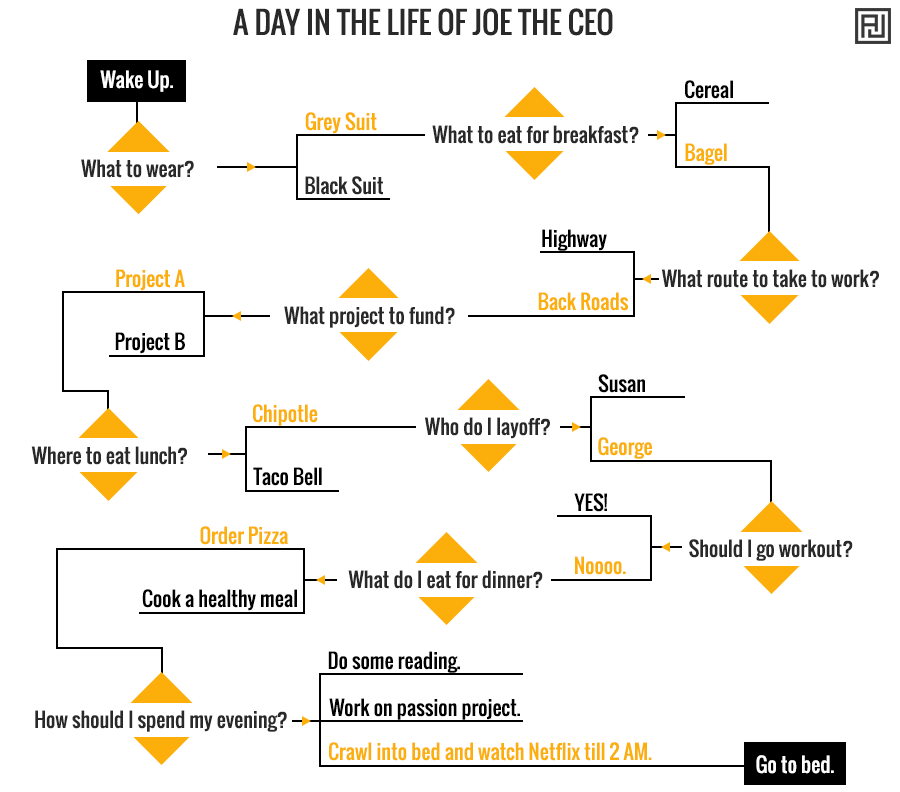Y
ou know when you plan to cook a healthy meal for dinner, but instead end up eating fast food or ordering pizza? Or how about when you plan to workout after work only to end up in front of the TV watching Netflix for hours? These are just a few examples of how decision fatigue may be affecting your life.
What Is Decision Fatigue?
In the simplest of terms, decision fatigue refers to how your decision making ability gets worse throughout the day. The more decisions you make, the harder it gets to make good decisions.
This deteriorating quality of decision making often results in one of two outcomes:
1. Impulsive Decisions: where you make a decision irrationally
2. Avoidance Decisions: where you do not make a decision at all
Can you think back on a time in your life when this has happened to you? I’m sure the examples above are familiar for many. Let’s walk through an example with our good friend Joe, the CEO of a corporation, and see how decision fatigue can impact a hypothetical day.
Here are the decisions he had to make: what to wear, what to eat for breakfast, what route to take to avoid traffic, what project the business should fund, where to eat lunch, which employee he has to layoff, whether to workout or go home for the day, what to eat for dinner, and whether to work on his passion projects before bed. This is of course a simplified version, but you get the idea. The decision making of Joe the CEO is clearly waning as the day progresses.
How Does It Work?
The phenomenon is pretty common at the end of a long day or when you’re low on energy (sleepy or hungry). It has also been closely linked to the idea of ego depletion.
Ego depletion is the concept that willpower is a limited resource that can be used up over the course of a day. As that resource runs low, self-control is impaired and one would be in a state of ego depletion. You can clearly see the commonalities here, as your willpower diminishes, so will your ability to make decisions.
Author of the book Willpower, John Tierney, says, “You only have a finite amount [of willpower] as you go through the day, so you should be careful to conserve it and try to save it for the emergencies.”
In this sense, your ability to make decisions or utilize willpower is thought of as a muscle. It is worked out throughout the day, but can only do so much before it is exhausted. This analogy is interesting for several reasons:
1. It can get stronger: Just like a muscle, you can improve your willpower and ability to make decisions the more you exercise it. You won’t see much difference in the short term, but long term it does get stronger.
2. It can get burned out: If you have to make decision after decision, eventually you’re going to be depleted. There are only so many major decisions an individual can make during a single day, so it is important to be aware of this limit.
3. It heals with rest/nourishment: Again, much like a muscle, rest heals and replenishes your ability to make decisions. In this regard, sleeping, napping, or turning off your brain for a bit can all be beneficial, especially after a taxing day. Furthermore, low energy can also hurt decision making, so eating also has a positive impact on replenishing your willpower.
Clearly managing your decision fatigue is a big deal, so how do you do it?
How To Manage Your Decision Fatigue
While decision fatigue is something that we all deal with, there are a few ways that you can organize your life and design your day to maximize your ability to make better decisions.
1. Be Mindful of Your Decisions
This is probably the first step to take. Simply take stock of the decisions that you’re making throughout the day. Which ones do you struggle with? Which are easy? How many do you make? When do they happen? Being aware of them will give you a good idea of how you can adjust your day to make it more efficient.
2. Prepare the Night Before
A simple trick is to make a number of the smaller decisions the night before, so that those don’t take away from the limited resource. In this sense, picking out your clothes, making breakfast/lunch, and planning your day can save you from a lot of fatigue that will be better utilized in more meaningful situations.
3. Start the Day With the Hardest Task
There’s almost always one big thing on our list that we dread doing and surprisingly that often coincides with the most important task. It’s vital to tackle that task from the beginning, when we’re operating at our highest level of decision making and willpower. That way, you’re much less prone to take irrational or impulsive action and have the needed resources to complete the task.
4. Take a Break
As mentioned above with regards to decision fatigue being like a muscle, giving yourself a break can do wonders. Eating something (healthy of course) or taking a power nap can give you a boost and allow you to regenerate a bit of willpower to use for the rest of an arduous day.
5. Simplify & Remove Temptation
Simplifying is essentially where you take decision making completely out of the process. This is why Steve Jobs always wore the same clothes everyday, he removed the decision from the equation. Similarly, if you make your lunch for the week, you remove the temptation to eat out at all because you already have lunch. There are many ways you can simplify and remove temptation, from accountability to schedules, and these small steps can go a long way in forming better habits that can eventually replace the decision making process altogether.
__________
In the absence of willpower the most complete collection of virtues and talents is wholly worthless.Aleister Crowley
If you make the effort to actually manage your decision fatigue, you could completely change your daily outlook. From success to health to happiness, everything is within reach by being aware of your willpower and how you use it.
We often don’t think about willpower when it comes to our behavior, but it’s a major factor in our well-being. Don’t overlook the value of this practice and give it a shot, even if it is as simple as picking your clothes out or making your lunch for the next day. See how it goes and let me know.
Image via flickr


